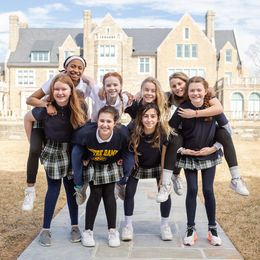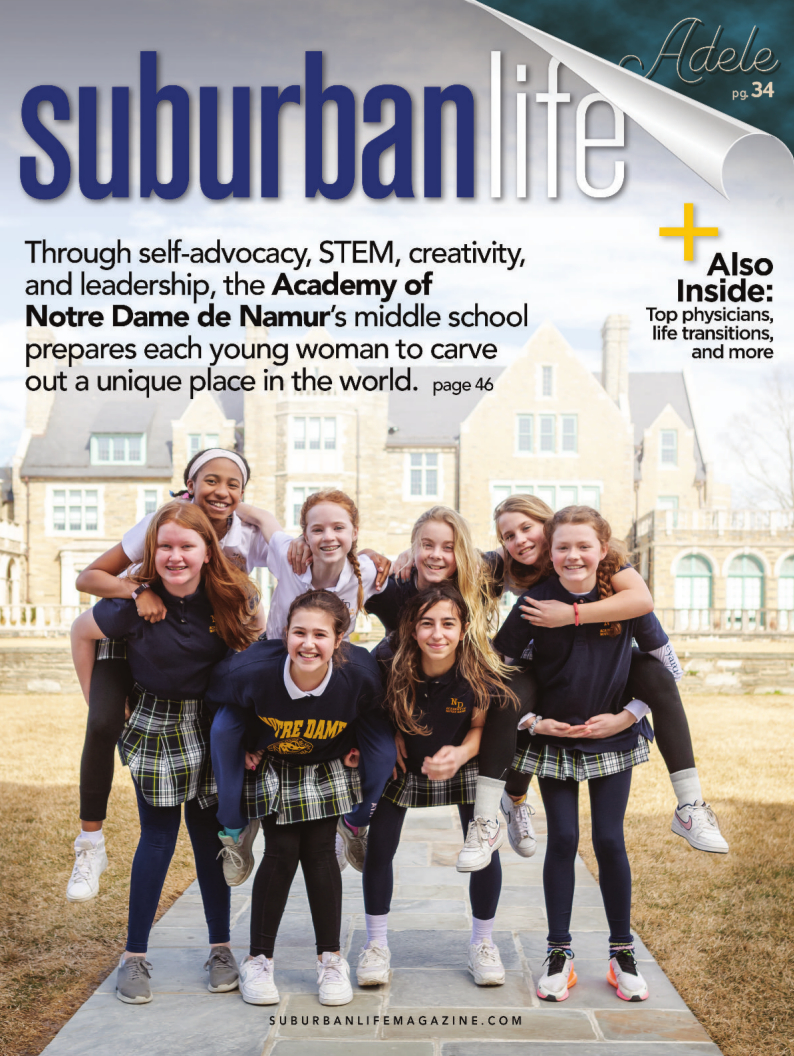
Ready to Lead
Through self-advocacy, STEM, creativity, and leadership, the Academy of Notre Dame de Namur’s middle school prepares each young woman to carve out a unique place in the world.
By definition, middle school represents a time of transition, questioning, and exploration. The Academy of Notre Dame de Namur, an all-girls’ college-preparatory school located on 39 picturesque acres in Villanova, not only prepares middle school students for the academic journey ahead, but also prepares them to make deeper connections with the world around them.
“We devote a lot of attention to students’ individual learning needs, as well as their social development,” says Laura M. Hotchkiss, Ed.D., who became Notre Dame’s Head of School in July 2021. “The middle school curriculum prepares students academically while helping them develop self-advocacy skills, how to ask for help, and how to be engaged in class—with their classmates and with their teachers. It’s a sisterhood at Notre Dame.”
Founded in 1856, the Academy of Notre Dame de Namur is guided by the faith tradition of the Catholic Church and the service of the Sisters of Notre Dame de Namur. The school strives to provide a caring, inclusive, and inspirational community for girls in grades six through 12.
“In my first year at Notre Dame, I’m spending a lot of time listening and learning,” says Dr. Hotchkiss, who prior to coming to Notre Dame was associate head of academics for Marlborough School in Los Angeles. “I think what sixth-grade parents are excited about is the amount of personal attention the students get, and the amount of connection they have to an adult in the school.”
The process of strengthening students’ social connections begins in sixth grade with an advisory program, through which all students connect with an adult advisor who stays with them for the duration of their middle school experience. In the Seminar Series, students discuss a range of issues, from executive function to organization and conflict resolution.
Notre Dame’s middle school curriculum emphasizes both depth and breadth, according to Middle School Director Bridget Bonner.
“Notre Dame encourages our students to care for and lead others, to explore new adventures in the classroom, to connect with others in the school community, and to be compassionate outside of the gates,” she says. “Our students are fearless in their language arts classes, on the stage, and on the field. They have leads in performances, are captains on the basketball team, create sets for the musicals, and edit their yearbook.”
To her point, girls discover a world of possibilities at Notre Dame—new cultures and languages, history and the sciences, and creative expression through fine arts and performing arts, all while deepening their faith and finding new sources of inspiration. In the process, young people begin to understand who they are and what’s important to them, according to Associate Head of School Liz Willis, Ph.D.
“Middle school may not be the most elegant or comfortable age, but it is an opportunity to take risks, ask questions, make mistakes, and do something different,” Dr. Willis says. “The best middle school experiences are when there are open fields of curiosity and creativity. Our students are given that here.”
A Notre Dame Middle School student will take six core academic classes. She will also discover opportunities to delve into the arts curriculum—chorus, dance, and visual and digital arts. Further development also comes through interactions with older peers, as students from Notre Dame’s middle and upper schools walk the same halls.
Dr. Willis underscores the importance of an all-girls’ educational experience. Specifically, she says girls in a single-gender environment tend to develop more self-confidence in the sciences, have higher levels of cultural competency, and strengthen their desire to get involved in the community.
“There is tremendous value in all-girls’ education, especially at the moment of preteen-hood and middle school,” she says. “In a multi-gender environment, girls in middle school are less prone to academic risk-taking and questioning. In a single-sex environment, however, we see the girls grow confidence, competence, a better sense of self, and a willingness to take risks.”
This knowledge compelled Notre Dame to create The Riley Center for STEM Education. Opened in April 2019, the 30,000-square-foot center includes technology-enabled active learning (TEAL) environments, with laboratories, classrooms, and other resources devoted to STEM subjects such as design and entrepreneurship, robotics, coding, and engineering. The school’s investment in STEM has paid off, as one-third of Notre Dame graduates pursue STEM majors in college, according to Dr. Hotchkiss.
“An impressive element of the middle school experience is the vast extracurricular club program, which is driven largely by student interest and leadership,” she adds. “Students can try opportunities in robotics, computer programming, justice, and women’s health issues, among others.”
As Dr. Hotchkiss discusses present-day Notre Dame, she recalls her own experience as a young woman. She was among the few girls in high school who were interested in STEM, and her interest wound up guiding her career path; prior to becoming an administrator, Dr. Hotchkiss taught various levels of mathematics.
“Since then, all-girls’ schools have changed in regard to their mission to empower students to go into the world,” she adds. “We value the importance of teaching girls science and all the skills young women will need when they enter the world. We want to make sure they’re prepared to go to college and know how to write a research paper, raise their hand and have something to say, and not be drowned out by male voices.
“That’s why we keep our class sizes intentionally small,” she continues. “Our teachers have their eyes on students every day. On any given day, our middle school director, Bridget Bonner, can go to a teacher and ask how a specific student did that day and get a full answer. That’s just another benefit we have here.”
Dr. Hotchkiss has worked in all-girls’ schools her entire working life, and she believes Notre Dame is unique in its development of each student’s mind, body, and spirit. Notre Dame students learn to enter the world as kind, strong, and well-rounded individuals who advocate for themselves.
“At Notre Dame, it’s about communication in all shapes and forms,” Dr. Hotchkiss says. “It’s about the written and spoken word, and data that’s critical to the future of education. The reality is that these girls may one day get jobs that don’t even exist yet. What’s important here at Notre Dame is to prepare them to be good people first.”
Academy of Notre Dame de Namur
560 Sproul Road
Villanova, PA 19085
(610) 687-0650
www.ndapa.org
560 Sproul Road
Villanova, PA 19085
(610) 687-0650
www.ndapa.org
Photograph by Nina Lea Photography
Published (and copyrighted) in Suburban Life magazine, February 2022.



